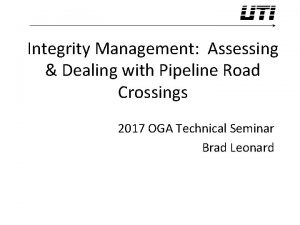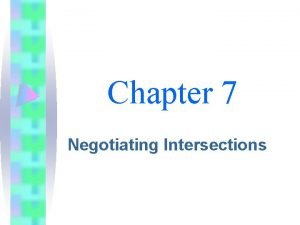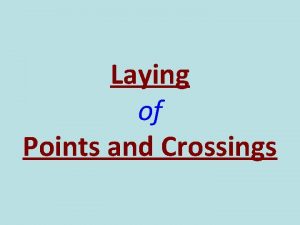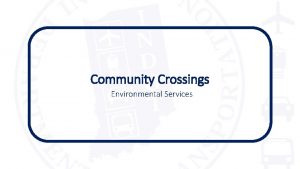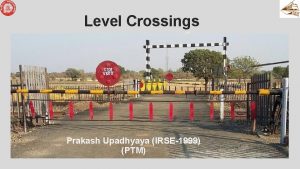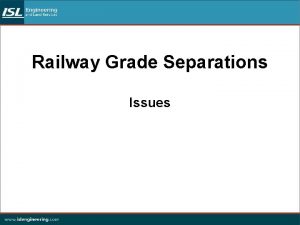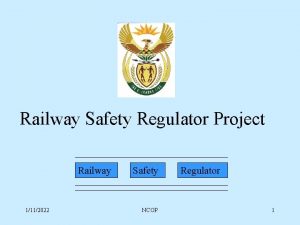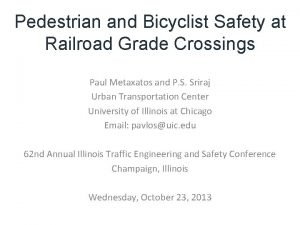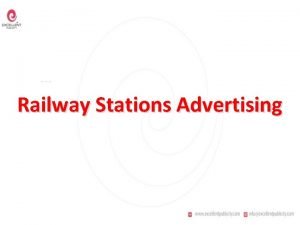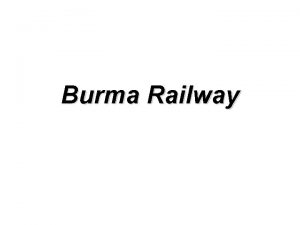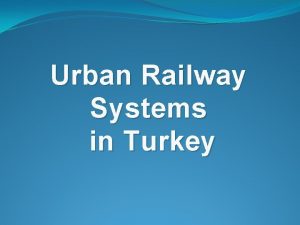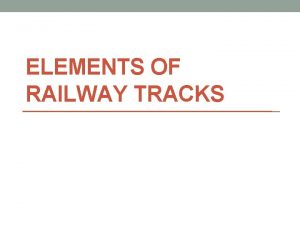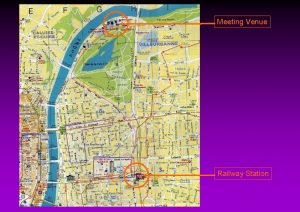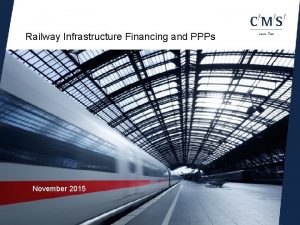Railway Safety at Grade Crossings An Overview of














- Slides: 14

Railway Safety at Grade Crossings An Overview of Stakeholder Roles and Federal Legislation at Grade Crossings May 18, 2016 presentation to CPWA Saskatchewan Chapter, Saskatoon

Grade Crossing Regulations and Standards ( November 28, 2014) Why? Pre 1990 Canadian Transportation Commission (CTC), (National Transportation Commission, Railway Transportation Commission), responsible for: - Railway Act, all things, including new crossings approved by Federal Government

Grade Crossing Regulations and Standards Post 1990, CTC split into: • Canadian Transportation Act (CTA) administered by the Canadian Transportation Agency - Legal right to cross a railway - Suitable crossing - Dispute resolution and apportionment of $$ • Railway safety Act (RSA) administered by Transport Canada - Safe operations of railways - Safe crossing design and operation • Canadian Transportation Accident Investigation and Safety Board Act administered by Transportation Safety Board - Accident investigation

Grade Crossing Regulations and Standards 1990 - 2014 • Grade Crossing Regulation - Needs evaluation, - Evaluation of options - Development of standards - Consultation on Draft Regulations and Standards (1990) - Rewrite of regulations and standards - Consultation on Draft (RTD-10, 1993, 1995, 2002, 2011 -12) - Gazette I (February 2014) - Consideration and evaluation of gazette comments, rewrite of regulations and standards - Regulatory Impact Analysis - Gazette II - Registered (CIF) November 27, 2014 - G II December 17, 2014

Grade Crossing Regulations and Standards Effective immediately (Nov 28, 2014): New requirements for new or significantly altered crossings. Whistle cessation requirements specified. Collaborative process for railways and road authorities to resolve safety concerns at blocked crossings created (GCR s. 98). Mandatory communication requirements between railway and road authority when automatic warning systems fail. Testing requirements for automatic warning systems.

Grade Crossing Regulations and Standards Effective immediately (Nov 28, 2014): New requirements for new or significantly altered crossings. Whistle cessation requirements specified. Collaborative process for railways and road authorities to resolve safety concerns at blocked crossings created (GCR s. 98). Mandatory communication requirements between railway and road authority when automatic warning systems fail. Testing requirements for automatic warning systems.

Grade Crossing Regulations (GCR) • • • Interpretation Application Compliance Information Sharing Sightlines New Grade Crossings Existing Grade Crossings Changes to Grade Crossings Audible Warnings Records

Grade Crossing Standards (GCS) • • Incorporated by reference in the Grade Crossings Regulations (GCR) Minimum safety requirements for the general design, construction and maintenance of grade crossings Phased-In approach regarding effective compliance dates, detailed in the GCR Includes the following : • Part B - Existing Grade Crossings • Part C – New Standards • Part D – Design Calculations • Part E – Warning System Design • Part F – Interconnected Devices • Appendices

Grade Crossing Guidelines Table 2: Presently in-force 3 for EXISTING PUBLIC grade crossings (To be replaced by the relevant Grade Crossings Regulation requirements at Year 7) Sightlines Guidelines: • Minimum Railway/Road Crossing Sightline Requirements for All Grade Crossings Without Automatic Warning Devices G 4 -A • Draft RTD 10 Road/Railway Grade Crossings, 2002 Signage Standard: • Grade Crossings Regulation, Section 58 Ø Grade Crossing Standards, Part B Surface Standard: • Grade Crossings Regulation, Section 58 Ø Grade Crossing Standards, Part B Signals Guidelines (design, construction): Draft RTD 10 Road/Railway Grade Crossings, 2002 Standard (inspection, testing, maintenance): • Grade Crossings Regulation, Sections 93 -96 Ø Grade Crossing Standards, Article 17 Standards from the GCR can be considered as best-practice until Year 7 3 Note that each crossing type has particular requirements detailed separately in the Grade Crossing Regulations (GCR). All stakeholders are encouraged to carefully review the GCR to identify the relevant requirements for the various crossing types.

Grade Crossing Regulations and Standards Year two requirements (Nov 28, 2016): Railways and Road Authorities must share basic information (design vehicle, design speed, etc. . . ) so that the minimum sightlines of trains; minimum light distribution and warning times of automatic warning systems can be determined.

Year seven requirements (Nov 28, 2021): Sightline requirements must be met. Crossing surface requirements must be met. Crossing signage standardization. Minimum light distribution and alignment standards must be met Minimum warning times of automatic warning systems must be met.

Roles at Public Grade Crossings – Road Authority 1. Sightlines: along the road right of way to ensure the crossing, crossing warning signals, and signage are visible to approaching crossing users; jointly responsible for sightlines over adjacent land for passive crossings; 2. Surface : sidewalks/pathways, the road surface in between TRACKS when two or more tracks, shared responsibilities with the railway for grade crossing surfaces (pending agreements); 3. Signage : speed tabs, stop signs, advanced warning signs, other roadway or pedestrian focused signage; 4. Signals: traffic control devices on road approaches, devices that interconnect with grade crossing warning systems, street or flood lighting, shared responsibilities with the railway for grade crossing warning systems (pending agreements) 5. Other : removal of snow from the road for the safe passage of vehicles, bicycles, pedestrians and persons using assistive devices over the grade crossing; drainage along the roadway right of way; pavement markings 2 Pavement markings recommended to be installed per the latest edition of the Transportation Association of Canada (TAC) Manual of Uniform Traffic Control Devices (MUTCD) 2

Roles at Public Grade Crossings – Railway Company 1. Sightlines: along the railway right of way to ensure the crossing, crossing warning signals, and signage are visible to approaching crossing users; jointly responsible for sightlines over adjacent land for passive crossings; 2. Surface : the road surface between the RAILS of each track and up to the ends of the railway ties, the elevation of the railway tracks in relation to the road, shared responsibilities with the road authority for grade crossing surfaces (pending agreements); 3. Signage : railway crossing signs, number of track signs, emergency signs; 4. Signals: full or shared responsibilities with the railway for grade crossing warning systems (pending agreements) 5. Other : removal of snow along the railway right of way , drainage along the railway right of way.

QUESTIONS?
 Hot applied wax casing filler
Hot applied wax casing filler A controlled railroad crossing is identified by
A controlled railroad crossing is identified by Uncontrolled railroad crossings usually have ______.
Uncontrolled railroad crossings usually have ______. Points and crossings
Points and crossings Controlled railroad crossings usually have
Controlled railroad crossings usually have Catzoc ecdis definition
Catzoc ecdis definition Safety care behavioral safety training
Safety care behavioral safety training Personal safety vs process safety
Personal safety vs process safety Safety assessment for ind safety reporting
Safety assessment for ind safety reporting Basic safety orientation
Basic safety orientation 00101-15 basic safety
00101-15 basic safety Raw score transmutation table
Raw score transmutation table Cinderella kissed a fella
Cinderella kissed a fella Culinary
Culinary Milk grades
Milk grades
